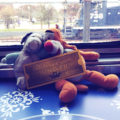St. Louis — July 20, 2023 — Discovery Channel’s wildly popular Shark Week turns America’s attention to the ocean’s most popular predators each summer. The St. Louis Aquarium at Union Station is celebrating this pop culture phenomenon, July 23-30 with a variety of shark-related opportunities for guests.
Pop Culture’s Favorite Predators are Celebrated, July 23-30, 2023
“We are excited to help people learn about these apex predators and develop a respect for them,” said Tamil Brown, executive director of the St. Louis Aquarium at Union Station. “Once you know more about sharks, you’ll understand they aren’t the crazy attack animals they’re portrayed to be. It’s important to develop a respect for them and their natural behaviors.”
EXPLORE SHARK CANYON
Shark Canyon is the largest habitat at the St. Louis Aquarium. At 250,000 gallons, it is home to a wide variety of shark species as well as stingrays, sea turtles and fish. Visitors can enjoy a Dive Show at Shark Canyon’s large viewing wall every day but Tuesday at 1:15 p.m. Divers wear a special scuba mask that allows them to talk with visitors and answer questions about caring for and diving with the sharks.
TOUCH A SHARK
At the Touch Pool on the second floor of the St. Louis Aquarium, visitors can reach into the water and touch a Bamboo Shark or a Coral Catshark. the habitat also is home to a variety of stingrays, horseshoe crabs and other marine animals. Guests may even by able to feed the friendly stingrays during their visit.
MAKE A SHARK HAT
Young visitors can make their own paper shark hats in the Kids Zone where they also can color a fish and launch it into the virtual water, read boks about fish and play games.
SHARKS BEHIND THE SCENES: WALK THE ROPE BRIDGE
Guests can walk the rope bridge across the top of Shark Canyon behind the scenes — if they dare. Stretching over Shark Canyon, the hand-knotted rope nridge is 15-feet-long and hangs 7.5-feet above the water of the Aquarium’s 250,000-gallon habitat for sharks, rays, sea turtles and thousands of fish. Like all of the best and scariest rope bridges, it shakes as visitors cross the span. The bridge crossing is part of the Aquarium’s behind the scenes tour add-on experience, open daily during normal operating hours. The tour also includes a visit to the Life Services area where salt water is created, monitored and filtered to keep the marine animals healthy; a stop in the veterinary lab; and a look at the kitchen where restaurant-quality food is prepared for the animals.
SHARK SPECIES AT THE AQUARIUM
Visitors to the St. Louis Aquarium at Union Station can see the following species;
— Sandbar/Brown Sharks
— Blacknose Sharks
— Zebra Sharks
— Whitetip Reef Sharks
— Black Tip Sharks
— Nurse Sharks
— Bonnethead Sharks
— Bamboo Sharks
— Cat Sharks
SHARK OF THE DAY
During Shark Week, Aquarium fans can touch replicas of shark teeth and jaws and will get in depth information on shark species living on site. Examples include:
Blacknose Sharks
A lot of guests think these are “baby sharks” but they are getting close to full grown. They’ll grow to about four feet long and weigh between 15 and 24 pounds at maturity. They get their name from the black spot on the tip of their snouts. Blacknose sharks are quick swimmers, so in the wild, they would eat small fish like anchovies or porcupine fish. At the Aquarium, they are fed them sardine, capelin (a schooling fish), squid, herring, or mackerel. All of the sharks are target fed to avoid competition over the food and to train them where to go to seek food when they want it.
Zebra Sharks
Zebra sharks have stripes when they are juvenile and as they grow older, the stripes turn into spots. They can grow to be nearly eight feet long and their tail can be about half of that length, so the Aquarium’s sharks still have some growing to do. Zebra Sharks are one of the few species of sharks that can breathe without swimming, so sometimes guests will see them hanging out on the sandy bottom or even on top of one of the viewing windows. They live in shallow coral reefs in warm tropical water in the Indo-West area of the Pacific Ocean, the Red Sea, East African and Australia. They are nocturnal, which means they are most active at night. In the ocean, they would hunt for small fish, snails, sea urchins and crabs that hide out in the coral reefs. Those “whiskers” or barbels at the front of their snouts help them to locate their prey and they can wriggle into tight spaces where these small fish often hide. They also have strong gill muscles so they can suck up prey. At the Aquarium, they are fed a variety of fish, including capelin, squid (their favorite), mackerel, and salmon.
Nurse Sharks
Nurse sharks grow to 7 to 10 feet and can weigh 200 to 330 pounds so they will definitely be the biggest sharks at the Aquarium. They are nocturnal like the Zebra Sharks. No one is entirely sure how they got their name. It could come from the sucking sound they make when hunting for prey in the sand, which sounds like a nursing baby. Or it could be from an old word that isn’t used anymore “nusse” which means cat shark. But the most likely reason is that it comes from an Old English word for sea-floor shark, “hurse.” They eat off the bottom like Zebra sharks, but they use their strong jaws to crush shellfish and even coral but they prefer small fish, shrimp and squid. At the Aquarium, they eat mackerel, herring, salmon, squid, or bonito. Both the zebra sharks and nurse sharks get clams and mussels to hunt for and crush up along the bottom of the exhibit.
Sandbar or Brown Sharks
They average about 6 feet long and weigh between 110 and 150 pounds when they are full grown. At the Aquarium, the Sandbar sharks eat large fish like mackerel, bonito, and salmon. In the wild, they are what’s called “opportunistic” feeders, which means they aren’t very picky. They prey mostly on small fish, eels, stingrays, octopus, shrimp and crabs. These sharks can be found all over the world. They are a shallow coastal species that likes warm tropical waters and they are bottom-dwelling. They can be found in the western and Eastern Atlantic, the Mediterranean and the Indo-Pacific, ranging from south and east Africa to the Hawaiian Islands.
IF YOU GO: ST. LOUIS AQUARIUM VISITOR INFORMATION
The St. Louis Aquarium is open daily from 9 a.m. until 5 p.m.with extended hours until 8 p.m. on Fridays and Saturdays. The attraction is part of the St. Louis Union Station family entertainment destination in downtown St. Louis at 201 S.18th St., St. Louis, MO 63103. Timed admission tickets can be purchased online at www.stlouisaquarium.com. Find the Aquarium on social media at: @aquariumstl.
Tickets are available combining Aquarium admission with other attractions at Union Station, including the 200-foot-tall St. Louis Wheel, mini-golf, the St. Louis Carousel, the St. Louis Ropes Course the Mirror Maze and the newly opened Selfie Express. Buy online to take advantage of plan-ahead pricing.
Restaurants on site include the retro-style diner Soda Fountain, Train Shed, The Pitch Athletic Club & Tavern and the 1894 Cafe. Fire and light shows are set to music and play on the Union Station lake throughout the day and evening.
The St. Louis Union Station Hotel, a Curio Collection by Hilton, can be booked with an Aquarium Package at https://www.stlouisunionstation.com/hotel-packages.
Discover more from St. Louis Dad
Subscribe to get the latest posts to your email.







